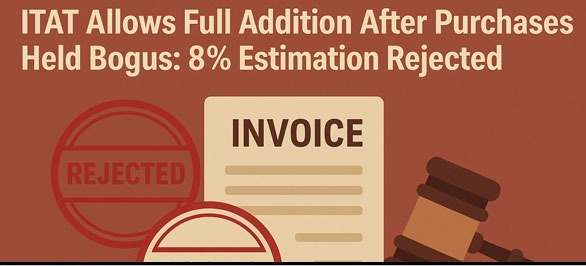G.S. Singhvi, J.@mdashIn this appeal filed u/s 260A of the Income Tax Act, 1961, the appellant has sought determination of the following question of law :
"Whether, on the facts and in the circumstances of the case, the Income Tax Appellate Tribunal was justified in law in holding that the impounded diary of the property dealer recording actual transactions in the properties located in that very area had no evidentiary value ?"
2. The facts necessary for deciding this appeal are that by an order, the Assessing Officer finalised the assessment of the respondent u/s 143(1) on a total income of Rs. 15,320 but in pursuance of a search and seizure operation conducted at the business premises of the firm, Mohar Singh Ishwar Dayal, Ballabgarh, and the residential premises of Shri Vidya Rattan, he made an addition of Rs. 1,45,000 by treating the purchase of the plot in the name of the assessee''s minor son as unexplained investment. The appeal filed by the assessee was allowed by the Commissioner of Income Tax (Appeals) vide his order dated July 31, 1991, and that order was upheld by the Income Tax Appellate Tribunal while dismissing the appeal filed by the Revenue. The reasons recorded by the Commissioner of Income Tax (Appeals) for deleting the addition made by the Assessing Officer read as under :
"(i) The return showing an income of Rs. 9,350 was filed on July 30, 1987. The Assessing Officer has observed that search and seizure operations were conducted on the business premises of Mohar Singh Ishwar Dayal, Ballabgarh, and at the residential premises of the assessee''s father, Sh. Vidya Rattan on October 29, 1987. The documents seized during the search revealed that Plot No. 583 in Sector 15, Faridabad, had been purchased in the name of the assessee, minor, on May 12, 1986, for a total consideration of Rs. 45,000. Subsequently, notice u/s 148 was issued to bring to tax the unexplained investment in the acquisition of the plot. The assessee filed the return in response to a notice u/s 148 declaring an income of Rs. 9,346.
(ii) It has been observed in para. 6 of the assessment order, ''since the plot has been purchased in the name of the minor, the investment in the purchase of plot and construction thereof, is being considered in the case of the assessee also on protective basis. This finding is, however, without prejudice to any action to be taken in the case of the firm as well as Shri Vidya Rattan, father of the assessee.'' The Assessing Officer held that the cost of the plot shown was very low as compared to the existing market price. Accordingly, the Assessing Officer estimated the market value of the plot at Rs. 1,90,000 and after deducting the investment of Rs. 45,000 shown by the assessee, added the difference of Rs. 1,45,000 as unexplained investment in the plot.
(iii) An identical addition was made in the hands of Sh. Vidya Rattan, father of the assessee, in the assessment year 1987-88. In fact, the aforesaid addition in the hands of the assessee has been made on a protective basis as the substantive addition was made in the hands of Sh. Vidya Rattan. In my appellate order dated June 26, 1991, in Appeal No. 103 of 1991-92 for the assessment year 1987-88 in the case of Sh. Vidya Rattan, father of the assessee, the issue of unexplained investment in the aforesaid plot was dealt with and examined by me in detail. Following my appellate order, supra, and for the reasons stated therein, as the addition in the hands of Sh. Vidya Rattan has been deleted, the addition of Rs. 1,45,000 made in the hands of the assessee on a protective basis is, accordingly, deleted. The assessee would get relief of Rs. 1,45,000 as a result of this order."
3. The Income Tax Appellate Tribunal upheld the deletion by making the following observations :
"12. We have carefully considered the facts, the material available on record and the rival submissions. We find that the addition on account of unexplained investment could only be made u/s 69 of the Act. Section 69 of the Income Tax Act provides that where in the financial year immediately preceding the assessment year the assessee has made investments which are not recorded in the books of account, if any, maintained by him for any source of income, and the assessee offers no explanation about the nature and source of the investment or the explanation offered by him is not, in the opinion of the Income Tax Officer, satisfactory, the value of the investments may be deemed to be the income of the assessee of such financial year. The simple reading of the section would show that the following are the pre-requisites for invoking of the provisions of Section 69 of the Income Tax Act :
(a) That the assessee has made investment ;
(b) Such investment is unexplained.
In the present cases, the assessees involved, have purchased the plots for a consideration of Rs. 35,000/Rs. 45,000 as recorded in the sale deeds. The Revenue claims that the total investment made is at Rs. 3,66,400 and there is unexplained investment of Rs. 2,86,400 but as would be seen from the facts given, there is no material evidence to establish that the assessee made investment of Rs. 2,86,400 over and above that recorded in the sale deeds at Rs. 80,000. In the absence of any such evidence, and the invest- ment having been proved, no addition could be made u/s 69 of the Income Tax Act. This view is fully supported by the aforecited decisions of the Tribunal. Moreover, the assessees have laid cogent evidence by way of receipts and copies of sale deeds to show that the assessees acquired the said plots for a consideration of Rs. 55,000/Rs. 45,000 and the diaries of property dealer relied upon by the Revenue do not prove that the assessee paid a consideration of Rs. 3,66,400 to the vendors against the apparent consideration shown at Rs. 30,000. Further, according to learned counsel, the vendors sold the said plots before leaving India for abroad and this could also be a distress sale. Such facts have not been controverted by the Revenue- The Revenue has also not made any enquiries from the property dealers, vendors, etc., to establish that the assessee paid any amount, over and above the apparent consideration in purchase of the said plots. We also find that for similar reasons, the Tribunal in the aforecited cases, deleted the addition made vide order dated March 27, 1996, in I. T. A. Nos. 3865 and 3953/Delhi of 1990 for the assessment year 1984-85 in the case of Mrs. Shakuntala Bhatia and order dated January 21, 1992, in I. T. A. No. 2701/Delhi of 1990, for the assessment year 1980-81 in the case of Smt. Santosh Gupta.
Having regard to the facts and material, we see no infirmity in the orders of the Commissioner of Income Tax (Appeals) and the same are upheld."
4. A perusal of the reasons assigned by the Commissioner of Income Tax (Appeals) and the Tribunal shows that similar additions made by the Assessing Officer in other cases were deleted by the Commissioner of Income Tax (Appeals) and his orders were upheld by the Tribunal. It has not been shown to us that the orders passed by the Tribunal in similar cases are the subject-matter of any reference pending before this court or any appeal pending in the Supreme Court. Therefore, we do not find any valid ground to interfere with the concurrent findings recorded by the Commissioner of Income Tax (Appeals) and the Tribunal.
5. For the reasons mentioned above the appeal is dismissed.

